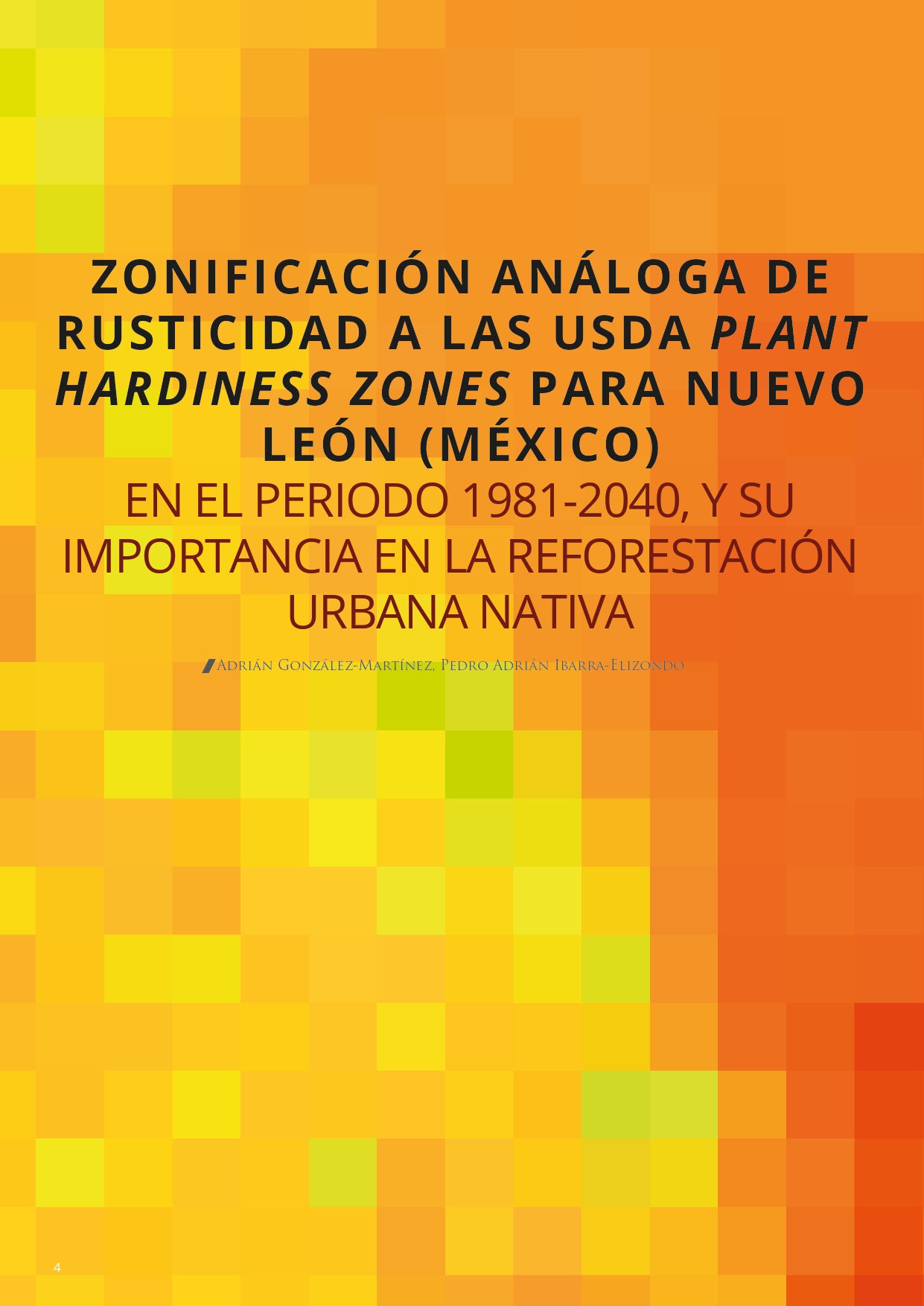Zonificación análoga de rusticidad a las USDA Plant Hardiness Zones para Nuevo León (México)
En el periodo 1981-2040, y su importancia en la reforestación urbana nativa
DOI:
https://doi.org/10.29105/bys6.12-84Keywords:
Plant Hardiness Zones, USDA, Nuevo León, Landscaping, Nurseries, Urban trees, HorticultureAbstract
Plant hardiness zones are geographic areas defined by significant climatic or biological conditions for the growth of plant species. In many countries, these zones are used to help improve the effectiveness of landscaping projects and in the agricultural industry. The United States Department of Agriculture (USDA) has defined 14 hardiness zones based on average minimum temperatures over several years or decades, with a difference of 10 °F (5.6 °C) between each zone. This study aims to create analogous zoning for Nuevo León, Mexico, using bioclimatic layers from CHELSA Bioclim and the same temperature ranges as the USDA. The goal is to help in
the selection of urban tree species that are suitable for the climatic conditions of the area and to avoid massive losses in case of extreme cold events. Cartography is generated for Mexico and the contiguous United States, Nuevo León, and the Metropolitan Area of Monterrey, as well as a list of native species suitable for urban reforestation projects.
Downloads
References
AccuWeather. 2022. February 2021. Monthly Temperatures. En: https://www.accuweather.com/en/mx/monterrey/244681/february-weather/244681?year=2021 (consultado el 04/07/2022).
Alanís-Flores, G. J., Cano-Cano, G., y Rovalo-Merino, M. 1996. Vegetación y Flora de Nuevo León, una Guía Botánico-Ecológica. CEMEX.
Alanís-Flores, G. J., y González-Alanís, D. 2003. Flora Nativa Ornamental para el Área Metropolitana de Monterrey. Universidad Autónoma de Nuevo León; R. Ayuntamiento de Monterrey
Aram, F., Higueras-García, E., Solgi, E., y Mansournia, S. 2019. Urban green space cooling effect in cities. Heliyon. 5(4). e01339. https://doi.org/10.1016/j.heliyon.2019.e01339
Cantú, R. 25 de febrero de 2021. Mueren plagas y árboles con clima gélido. El Norte. En: https://www.elnorte.com/mueren-plagas-y-arboles-con-clima-gelido/ar2132523 (consultado el 12/07/2022).
Carey, J. H. 1992. Quercus virginiana. En: U.S. Department of Agriculture, Forest Service, Rocky Mountain Research Station, Fire Sciences Laboratory (eds.) Fire Effects Information System. https://www.fs.usda.gov/database/feis/plants/tree/quevir/all.html
CHELSA Climate. 2022. CHELSA Bioclim. En: https://chelsa-climate.org/bioclim/ (consultado el 12/07/2022).
Dawson, I. 1991. Plant Hardiness Zones for Australia. Australian Horticulture. 89(9). 37-39. https://www.anbg.gov.au/gardens/research/hort.research/zones.html
Del Tredici, P. 1990. The New USDA Plant Hardiness Zone Map. Arnoldia. 5(3). 16-20. https://www.jstor.org/stable/42954386
Dong, W., Liu, Z., Liao, H., Tang, Q. y Li, X. 2015. New climate and socio-economic scenarios for assessing global human health challenges due to heat risk. Climatic Change. 130. 505–518. https://doi.org/10.1007/s10584-015-1372-8
Giddings, L. E., y Soto-Esparza, M. 2005. Plant heat zones for Mexico. Revista Chapingo: Serie Horticultura. 11(2). 365-369.
Gutjahr, O., Putrasahan, D., Lohmann, K., Jungclaus, J. H., von Storch, J.-S., Brüggemann, N., Haak, H., y Stössel, A. 2019. Max Planck Institute Earth System Model (MPI-ESM1.2) for the High-Resolution Model Intercomparison Project (HighResMIP). Geoscientific Model Development. 12. 3241–3281, https://doi.org/10.5194/gmd-12-3241-2019
Jang, J., y Leung, D. W. M. 2022. The Morpho-Physio-Biochemical Attributes of Urban Trees for Resilience in Regional Ecosystems in Cities: A Mini-Review. Urban Science. 6(2). https://doi.org/10.3390/urbansci6020037
Karger D. N., Conrad, O., Böhner, J., Kawohl, T., Kreft, H., Soria-Auza, R. W., Zimmermann, N. E, Linder, H. P., y Kessler, M. 2018. Data from Climatologies at high resolution for the earth’s land surface areas. EnviDat. https://doi.org/10.16904/envidat.228.v2.1
Karger, D. N., Conrad, O., Böhner, J., Kawohl, T., Kreft, H., Soria-Auza, R. W., Zimmermann, N. E., Linder, P., y Kessler, M. 2017. Climatologies at high resolution for the Earth land surface areas. Scientific Data. 4. 170122. https://doi.org/10.1038/sdata.2017.122
Kim, S. W., y Brown, R. D. (2022). Pedestrians’ behavior based on outdoor thermal comfort and microscale thermal environments, Austin, TX. Science of the Total Environment. 808. https://doi.org/10.1016/j.scitotenv.2021.152143
Klemm, W., Heusinkveld, B. G., Lenzholzer, S., y van Hove, B. 2015. Street greenery and its physical and psychological impact on thermal comfort. Landscape and Urban Planning. 138. 87–98. https://doi.org/10.1016/J.LANDURBPLAN.2015.02.009
Lobaccaro, G., y Acero, J. A. 2015. Comparative analysis of green actions to improve outdoor thermal comfort inside typical urban street canyons. Urban Climate. 14. 251–267. https://doi.org/10.1016/J.UCLIM.2015.10.002
Meza, J. 3 de febrero de 2022. Temen se repita una helada como la del 2011. El Heraldo de Juárez. En: https://www.elheraldodejuarez.com.mx/local/juarez/temen-se-repita-una-helada-como-la-del-2011-7814852.html (consultado el 10/07/2022).
Morgenroth, J., Östberg, J., Konijnendijk van den Bosch, C., Nielsen, A. B., Hauer, R., Sjöman, H., Chen, W., y Jansson, M. 2016. Urban tree diversity—Taking stock and looking ahead. Urban Forestry & Urban Greening. 15. 1–5. https://doi.org/https://doi.org/10.1016/j.ufug.2015.11.003
Nixon, K. C. 1997. Quercus fusiformis. En: Flora of North America Editorial Committee (eds.) Flora of North America – Vol. 3: Magnoliophyta: Magnoliidae and Hamamelidae. http://www.efloras.org/florataxon.aspx?flora_id=1&taxon_id=233501031
Patton, D. L. 2018. Hardiness Zones can be Confusing. Kansas State University Research and Extension. En: https://www.johnson.k-state.edu/lawn-garden/agent-articles/environment/hardiness-zones.html (consultado el 11/07/2022).
RHS. 2012. RHS hardiness rating. The Royal Horticultural Society. En: https://www.rhs.org.uk/plants/trials-awards/award-of-garden-merit/rhs-hardiness-rating (consultado el 12/07/2022).
Schwendenmann, L., y Mitchell, N. D. 2014. Carbon accumulation by native trees and soils in an urban park, Auckland. New Zealand Journal of Ecology. 38(2). 213–220. http://www.jstor.org/stable/24060799
SMN. 2022. Normales Meteorológicas por Estado – Quintana Roo – Estación 00023155 – Cancún, Benito Juárez – Valores Extremos. En: https://smn.conagua.gob.mx/tools/RESOURCES/Max-Extr/00023/00023155.TXT (consultado el 10/07/2022).
University of Maine. 2022. USDA Plant Hardiness Zone Map. University of Maine Cooperative Extension: Garden & Yard. En: https://extension.umaine.edu/gardening/manual/usda-plant-hardiness-zone-map/ (consultado el 12/07/2022).
USDA. 2012. USDA Plant Hardiness Zone Map. En: https://planthardiness.ars.usda.gov/ (consultado el 12/07/2022).
Widhalm, M., Robeson, S., Hall, B., Baldwin, M., y Coleman, J. 2018. Indiana’s Climate Trends: A Resource for the Indiana Climate Change Impacts Assessment. Indiana Climate Change Impacts Assessment - Purdue Climate Change Research Center. Climate Change Technical Reports. 1. http://dx.doi.org/10.5703/1288284316635
Wood, E. M., y Esaian, S. 2020. The importance of street trees to urban avifauna. Ecological Applications. 30(7). 1–20. https://doi.org/10.1002/eap.2149
WorldClim. 2022. Bioclimatic variables. En: https://www.worldclim.org/data/bioclim.html (consultado el 12/07/2022).
Yan, H., Wu, F., y Dong, L. 2018. Influence of a large urban park on the local urban thermal environment. Science of the Total Environment. 622–623. 882–891. https://doi.org/10.1016/j.scitotenv.2017.11.327

Downloads
Published
How to Cite
Issue
Section
Categories
License
Copyright (c) 2023 Adrián González-Martínez, Pedro Adrián Ibarra Elizondo

This work is licensed under a Creative Commons Attribution 4.0 International License.





